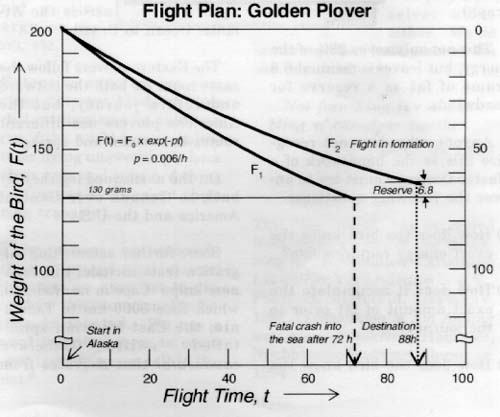The Golden Plover (Pluvialis dominica fulva) belongs to a family of small birds that migrate from Alaska to spend the northern winter in Hawaii.
To reach Hawaii they must fly non-stop over the ocean without resting, because there are no islands en route, neither can they swim.
An Impossible Flight Plan
During their 88-hour journey of more than 4000 km, they beat their wings an enormous 250,000 times without stopping. At the start, their average weight is 200 grams, 70 grams of which is padding (fat) which serves as fuel. It has been found that these birds consume 0.6% of their weight per hour to produce propulsion energy and heat.
(This extremely low specific rate of fuel consumption is astonishing: modern aircraft are orders of magnitude greater. A helicopter has a rate over 4%; a jet plane has a rate of about 12%.)
However, over the 88-hour journey their total fuel consumption would require 82.2 grams, which is more than the 70 grams they start out with!
In spite of flying at the optimum speed for minimal fuel consumption, the bird would not be able to reach Hawaii because it started out with too little fat. The 70 grams of fat will be consumed after 72 hours which is only 81% of the required flying time.
This would seem to doom the bird to a plunge into the ocean 800 km short of its destination. An analysis has been included here:

The Secret
What makes this ostensibly impossible flight possible is that the plover does not fly alone: he flies in formation! (This is depicted by curve F2 on the graph)
This not only saves 23% of the energy, but leaves a residual 6.8 grams of fat as a reserve for headwinds.
Anyone who does not recognize this as the handiwork of a Master Designer must try to answer the following questions:
- How does the bird know the exact energy requirements?
- How does it accumulate the exact amount of fat prior to the journey?
- How does the bird know the distance and the specific fuel consumption? And,
- How does the bird know to fly in a V-formation with other birds to reduce the fuel consumption?
A Greater Mystery
How does the bird know the migration route? How does the bird navigate to reach its destination efficiently?
Besides the Eastern Siberian golden plover described above, there is also the North American golden plover (Pluvialis nominatrasse).
These birds also undertake a non-stop long distance migration flight - from the coast of Labrador, across the Atlantic Ocean to Brazil.
The Eastern Siberian plovers follow the same route for both the outward and return journey, but the American plovers use different routes in autumn and spring.
On the northward leg they fly back to Canada over Central America and the U.S.
Some further astonishing migration feats include: the Japanese snipe (Capella hardwickii), which flies 5000 km to Tasmania; the East Siberian spine-tailed swift (Chaetura caudacuta) that migrates from Siberia to Tasmania; and the migration route of the American sandpiper (Calidris melanotus) that covers 16,000 km from Alaska to Tierra del Fuego at the southern tip of South America.
The birds' navigational abilities remain a mysterious puzzle. They have no gyroscopes, compasses, or maps; their environmental conditions - the position of the sun, wind direction, cloud cover, etc. - keep changing all the time.
Especially over the ocean, a small error in direction would result in floundering helplessly over the open water to their death. Flying over oceans, they take into account drift, they avoid wasting energy on detours, etc.
Extensive experiments conducting different kinds of birds to distant locations in unknown parts of the world have resulted in their flying unswervingly back to their eggs and young, defying any attempts to disorient them during transport.
They possess an astonishingly mysterious navigational ability and we have yet to discover how the operational information is decoded. We use a special technical term to cover up our ignorance: we call it "instinct."
We can't help but be reminded of God's taunting query to Job:
Doth the hawk fly by thy wisdom, and stretch her wings toward the south?
Job 39:26
Truly, everything in creation declares His handiwork! Praise His Name, indeed!
A Lesson for Ourselves
I was sharing all of this with Nan over breakfast and she - so characteristically - pointed out that the plight of the plover is just like our faith: we can't go the distance by ourselves alone either. We do better together, in formation. We are admonished:
...Not forsaking the assembling of ourselves together...
Hebrews 10:25
This "devotional" was excerpted from Werner Gitt, In the Beginning Was Information, Christliche Literatur-Verbreitung e.V., Postfach Bielefeld, Germany, 1997. (Translation of Am Anfang was die Information , Hanssler, Neuhhausen-Stuttgart, Germany, 1994.)




